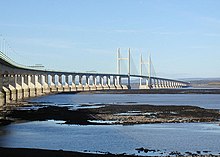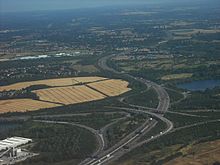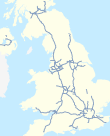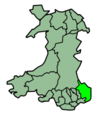M4 motorway: Difference between revisions
PeterEastern (talk | contribs) →Features: removed stray text duplicated from quote |
PeterEastern (talk | contribs) →M4 bus lane: removed content now in M4 bus lane |
||
| Line 78: | Line 78: | ||
===M4 bus lane=== |
===M4 bus lane=== |
||
{{main|M4 bus lane}} |
|||
{{split_section|date=October 2010}} |
|||
[[File:M4 bus lane.png|thumb|right|Location of bus lane]] |
[[File:M4 bus lane.png|thumb|right|Location of bus lane]] |
||
There is a {{Convert|3.5|mi|adj=on}} [[bus lane]] on the eastbound (London-bound) carriageway between Heathrow Airport and central London from junction 3 (A312) to the start of the elevated 2-lane section near [[Brentford]]. The lane which has no intermediate exits can be used by buses, coaches, motorbikes, emergency vehicles and licensed taxis but not mini-cabs.<ref name=bbc2009/> It opened as a pilot in June 1999 and was made permanent in 2001.<ref name=bbc2001 |
There is a {{Convert|3.5|mi|adj=on}} [[bus lane]] on the eastbound (London-bound) carriageway between Heathrow Airport and central London from junction 3 (A312) to the start of the elevated 2-lane section near [[Brentford]]. The lane which has no intermediate exits can be used by buses, coaches, motorbikes, emergency vehicles and licensed taxis but not mini-cabs.<ref name=bbc2009/> It opened as a pilot in June 1999 and was made permanent in 2001.<ref name=bbc2001/> On 1 October 2010 it was reported that the transport secretary, [[Philip Hammond]], was likely to announce at the conservative party conference that the lane would be suspended for 18 months from 24 December 2010 to be brought back for the [[2012 Summer Olympics]] after which it would be scrapped.<ref name=bbc_scrap>{{cite web|url=http://www.bbc.co.uk/news/uk-england-london-11451350|title=Government to scrap M4 bus lane|work=BBC News|date=2010-10-01|accessdate=2010-10-01|quote=The controversial M4 bus lane is due to be scrapped at the end of the year. Under the plans, all motorists will be able to use the {{Convert|3.5|mi}} lane which operates on the London-bound carriageway from near Heathrow}}</ref> |
||
A study by the [[Transport Research Laboratory]] 'Monitoring of the M4 bus lane: the first year' was produced in 2000<ref name=hov_lit/> reported that the £1.9m scheme had reduced [[rush hour]] journey times by 3.5 minutes for buses and one minute for cars. Off-peak car journey times were a minute longer due to a reduced speed limit which was cut from {{convert|70|mph|km/h}} to {{convert|50|mph|km/h}} and overall journey times had increased by 1.8%. CO2 emissions were cut by 16%, fuel consumption had improved by 16% and that noise levels were down by one decibel. [[Transport for London]] reported that the 7% of M4 traffic that used the bus lane carried 21% of the people.<ref name=bbc2001>{{cite news|title=Does this look like a U-turn?|publisher=[[BBC]]|url=http://news.bbc.co.uk/1/hi/uk/1119193.stm | date=18 January 2001 | accessdate=12 May 2010}}</ref> TRL produced a further report in 2003 'Monitoring of the M4 bus lane: 2000 to 2002'.<ref name=hov_lit/> A 2005 literature review of research into high-occupancy lanes produced for the Highways Agency reported that the lane was used about 3700 vehicles a day (3100 taxis, 500 buses or coaches and 100 minibuses) and that there was an overall benefit was 200 person-hours per weekday and a dis-benefit of 350 person-hours per weekend day; the dis-benefit being the result of the reduced speed-limit.<ref name=hov_lit>{{cite web|url=http://www.standardsforhighways.co.uk/pilots_trials/files/trl2005a.pdf|title=Literature Review of HOV Lane Schemes|accessdate=2010-10-01|quote=There is an overall benefit of 200 person-hours per weekday ... On average, 3700 vehicles a day use the bus lane. Of these, 3100 are taxis, 500 are buses or coaches and 100 are minibuses}}</ref> |
|||
On 1 October 2010 a [[Whitehall]] source was quoted saying that the business-case for removing the bus-lane showed time savings for all current non-bus lane users during the morning peak period and evening peak with no significant change in journey times for existing bus lane users'.<ref name=mail_buslane>{{cite news|url=http://www.dailymail.co.uk/news/article-1316710/M4-bus-lane-Tories-scrap-symbol-Labours-war-motorist.html?ITO=1490|title=End of the road for Prescott's M4 bus lane as Tories scrap 'symbol of Labour's war on motorist'|work=The Daily Mail|accessdate=2010-10-01|quote=The business case shows time savings for all current non-bus lane users during the morning peak period, with more savings during the evening peak. There is no significant change in journey times for existing bus lane users. There is believed to be no impact, either way, on safety.'}}</ref> During his speech to the Conservative Party conference Philip Hammond explained that removing the bus lane would result in 'shortening average journey times; reducing congestion; restoring a sense of fairness.<ref>{{cite web|url=http://www.conservatives.com/News/Speeches/2010/10/Philip_Hammond_Government_announces_plans_for_next_phase_of_high_speed_rail.aspx|title=Philip Hammond: Government announces plans for next phase of high speed rail|publisher=Conservative Party|date=2010-10-04|accessdate=2010-10-07|quote=And that means we can end Labour's indiscriminate war on the motorist as we focus on the real enemies - carbon and congestion. And nothing is more symbolic of that Labour war than the M4 bus lane. ... Yes, I can confirm today that from Christmas Eve this year until the Olympics, the M4 bus lane will be suspended. And once the Olympics are over, my intention is to scrap it permanently. Shortening average journey times; Reducing congestion; Restoring a sense of fairness. Consigning to the dustbin of history this hated symbol of the Prescott era.}}</ref> |
|||
Three [[Freedom of information]] requests were made the following day; one requested that two original TRL reports are released,<ref>{{cite web|url=http://www.whatdotheyknow.com/request/m4_bus_lane_monitoring_of_the_fi|title=M4 Bus Lane - Monitoring of the First Year Report|work=WhatDoTheyKnow|accessdate=2010-10-03}}</ref> the others requested more general information on the scheme and the recent decision to scrap it.<ref>{{cite web|url=http://www.whatdotheyknow.com/request/m4_bus_lane_suspension_plans|title=M4 bus lane suspension plans|work=WhatDoTheyKnow|accessdate=2010-10-03}}</ref><ref>{{cite web|url=http://www.whatdotheyknow.com/request/m4_bus_lane_highways_agency_data#incoming-118234|title=M4 Bus Lane - Highways Agency - Data Held|work=WhatDoTheyKnow|accessdate=2010-10-03}}</ref> |
|||
A number of [[Coach transport in the United Kingdom|UK coach services]] use the route. [[National Express Coaches]] services include: 030/032 ([[Portsmouth]]-London), 033 ([[Salisbury]]-London), 035 ([[Poole]]-London), [[National Express Coach route 040|040]] ([[Bristol]]-London), 402 ([[Frome]]-London), 403 ([[Bath, Somerset|Bath]]-London), 404/504 ([[Penzance]]-London), 413 ([[Hereford]]-London), 421 ([[Blackpool]]-London), 501 ([[Totnes]]-London), 502 ([[Westward Ho!]]-London), 505 ([[Newquay]]-London), 508 ([[Haverfordwest]]-London), 509 ([[Swansea]]-London) and 509 ([[Aberdeen]]-London); [[Megabus (United Kingdom)|Megabus]] operate [[Megabus Coach route M14|M14]] ([[Cheltenham]]-London), [[Green Line Coaches]] operate their [[Green Line routes 700, 701 and 702|701 and 702]] ([[Bracknell]]-London) service and Berry's Coaches the 351 ([[Tiverton, Devon|Tiverton]]-London) service. |
|||
The lane has been controversial since it was first introduced; In 2001 [[the Automobile Association]] suggested that it could only be deemed a success if 'significant numbers of drivers switched from their cars to public transport'<ref>{{cite news|title=M-way bus lane gets green light|url=http://news.bbc.co.uk/1/hi/uk/1120542.stm|publisher=[[BBC]]|date=2001-01-16}}</ref> and [[Jeremy Clarkson]] of [[Top Gear]] said he would 'vote for anyone who promised to tear up that stupid pinko bus lane'.<ref name=bbc2001/> In 2009 [[the Automobile Association]] described it as an underused '[[white elephant]]'. When announcing the suspension of the scheme in 2010 Philip Hammond said that 'Nothing is more symbolic of Labour’s war on the motorist', the [[RAC Foundation]] supported the move with director [[Stephen Glaister]] commenting that 'Most drivers on the M4 will wonder why this decision has taken so long'.<ref name=bbc_scrap/> ''[[The Sun (United Kingdom)|The Sun]]'' described the bus lane as 'insane'.<ref>{{cite web|url=http://www.thesun.co.uk/sol/homepage/news/3160852/Tories-to-ditch-that-insane-M4-bus-lane.htmla|title=Tories to ditch insane M4 bus lane|work=The Sun|accessdate=2010-10-01}} {{Dead link|date=October 2010|bot=H3llBot}}</ref> A [[Freedom of Information]] request in 2009 revealed that the bus lane was barely enforced, with only 20 [[fixed penalty notice]]s being issued in the preceding 18 months<ref>{{cite web|url=http://www.whatdotheyknow.com/request/m4_bus_lane_number_of_pcns|title=M4 Bus Lane Number of PCN's|work=What do that know|accessdate=2010-10-01|quote=I have asked for the information you require, and I can confirm that since 1st January 2008 there have been 20 fixed penalty notices issued.}}</ref> and that private drivers able to get away with regularly driving in it.<ref name=bbc2009>{{cite news| url=http://news.bbc.co.uk/2/hi/uk_news/england/london/8249919.stm | work=BBC News | title=M4 bus lane is 'barely enforced' | date=11 September 2009 | accessdate=12 May 2010}}</ref> |
|||
There is some speculation that the original plan involved closing one lane from junction 3 to the elevated section to prevent congestion caused by the filtering of three lanes of traffic into two (the motorway is already temporarily down to two lanes at junction 3 because the left lane is exclusively for traffic leaving the motorway, so the effect of the bus lane is to make the 3-to-2 lane-transition seamless). Making the "spare" lane available for buses - and now taxis and motorcycles - was an afterthought.<ref>{{cite web |
|||
|title=M4 Bus Lane|publisher=CBRD|author=Chris Marshall|url=http://www.cbrd.co.uk/indepth/m4buslane}}</ref> |
|||
===Porous road surface=== |
===Porous road surface=== |
||
Revision as of 06:06, 16 November 2010
| M4 | |
|---|---|
 | |
| Route information | |
| Part of | |
| Length | 189.5 mi (305.0 km) |
| Existed | 1961–present |
| History | Constructed 1961–1996 |
| Major junctions | |
| From | Chiswick 51°29′23″N 0°16′41″W / 51.4897°N 0.2781°W |
M25 motorway A308(M) motorway A404(M) motorway A329(M) motorway M32 motorway M5 motorway M48 motorway M49 motorway M48 motorway A48(M) motorway | |
| To | Pont Abraham services 51°44′42″N 4°03′54″W / 51.7451°N 4.0651°W |
| Location | |
| Country | United Kingdom |
| Primary destinations | Hounslow, Heathrow Airport, Slough, Maidenhead, Reading, Newbury, Swindon, Chippenham, Bristol, Newport, Cardiff, Bridgend, Port Talbot, Swansea, Llanelli |
| Road network | |
The M4 motorway links London with South Wales. It is part of the unsigned European route E30. Other major places directly accessible from M4 junctions are Reading, Swindon, Bristol, Newport, Cardiff and Swansea. Originally referred to as the London-South Wales Motorway, the English section was constructed between 1965 and 1971, the Welsh section was completed in 1993 and the Second Severn Crossing opened in 1996.
The M4 runs close to the A4 from London to Bristol. After crossing the River Severn it follows the A48 through Wales, using the Brynglas Tunnels at Junction 25a, Newport and terminates just north of Pontarddulais. The route of the M4 is known as the M4 corridor.
History

A new road from London to South Wales was first proposed in the 1930s, and the Ministry of Transport announced plans for the M4 as one of the first major post-war trunk road improvement projects in 1956.[1]
The motorway was built in several stages. In the 1960s two sections were built, one extending from the London end to near Maidenhead, one from north of Bath to west of Newport, including the Severn Bridge (opened in 1966 and now part of the M48). The Port Talbot by-pass, also built in the 1960s and now part of the M4, was originally the A48(M) motorway, a number now allocated to a short section of motorway near Cardiff. The Ministry of Transport originally intended that the M4 would terminate at Tredegar Park west of Newport, and it was only following the creation of the Welsh Office that the Government became committed to a high-standard dual carriageway to Pont Abraham in Carmarthenshire.[2]
The English section of the motorway was completed on 22 December 1971 when the 50-mile (80 km) stretch between junctions 9 and 15 (Maidenhead and Swindon) was opened to traffic.[3] The Welsh section was completed in 1993, when the Briton Ferry motorway bridge opened. The Second Severn Crossing opened in 1996, together with new link motorways on either side of the estuary to divert the M4 over the new crossing. The existing route over the Severn Bridge was redesignated the M48, and the new M49 was opened to connect the new crossing to the M5.[4]
In April 2005 speed checks carried out by police camera vans between junction 14 and junction 18 resulted in a public protest, involving a go-slow of several hundred vehicles along the affected sections of the motorway.[5]
In February 2010 it was proposed that the M4 in South Wales would become the first Hydrogen highway with Hydrogen stations provided along the route with an aspiration for further stations to be provided along the M4 into South West England over time.[6] A similar claim was made for a 30-mile (48 km) section of road in Scotland close to Aberdeen in September 2009 with refueling points at Bridge of Don, Ellon and Peterhead.[7]
Between 2007 and January 2010 the section from Castleton (Junction 29) to and Coryton (Junction 32) was widened to 6 lanes.[8][dead link] The scheme was officially opened in 25 January 2010 by the Deputy First Minister. Subsequent to opening there were occasional works with associated lane restrictions.[citation needed]
During 2009 the Newport section of the motorway between junctions 23a and 29 was upgraded with a new concrete central barrier. From 2010, a variable speed limit will be introduced.[9]

Features


Toll bridge
The M4 crosses the River Severn via a toll bridge, the second of only two on the UK motorway network – the first was the original Severn Bridge, now the M48. Tolls are charged in one direction only - westbound. Drivers therefore have to pay to enter Wales but not to enter England.
M4 bus lane

There is a 3.5-mile (5.6 km) bus lane on the eastbound (London-bound) carriageway between Heathrow Airport and central London from junction 3 (A312) to the start of the elevated 2-lane section near Brentford. The lane which has no intermediate exits can be used by buses, coaches, motorbikes, emergency vehicles and licensed taxis but not mini-cabs.[10] It opened as a pilot in June 1999 and was made permanent in 2001.[11] On 1 October 2010 it was reported that the transport secretary, Philip Hammond, was likely to announce at the conservative party conference that the lane would be suspended for 18 months from 24 December 2010 to be brought back for the 2012 Summer Olympics after which it would be scrapped.[12]
Porous road surface
Near Junction 35, there is a stretch of the motorway that has a surfacing of porous asphalt that improves drainage and reduces noise. When driving in heavy rain drivers notice a reduction in road spray from other vehicles and improved visibility. This special surface was publicised in an episode of the BBC's Tomorrow's World programme. This was the site of the first trial of the new road surface when it was laid down in 1993.[13]
Elevated and heated section
The elevated section in West London, built in the 1960s, is mostly directly above the A4 and extends over parts of Brentford's Golden Mile. This section was designed to have a heated road surface to reduce icing in winter, however, due to the high costs in preventing icing by this method the heating is no longer used.[citation needed]
Four level stack interchanges
It has two of only three four-level stack interchanges in the UK, including the first UK example at the junction with the M5 (J20/"Almondsbury Interchange") and the other at the junction with the M25 (J4B). Junction 4B also has to make provision for a railway line passing beneath the M4. Due to the nature of such junctions, it is impossible to make a U-turn at J20 or J4B.
Tunnels
The M4 passes through the Brynglas Tunnels at Junction 25a, Newport.
Notable junctions
Junction '8/9' (only one in the UK to feature a 'dual-numbered' junction) is the turn off for Maidenhead, Berkshire.
West of Junction 13 on the eastbound carriageway there are a set of sliproads signposted "Works Unit Only". The signs have red borders, implying a military exit. It is a back entrance to RAF Welford, a Second World War airfield and now an RAF/USAF military installation mainly used for storing munitions. The M4 entrance allows easier access for the large vehicles used to carry the munitions.
Junction 27 (High Cross) is a normal grade-separated roundabout junction. However the on-bound slip roads point in the opposite direction to the intended direction of travel. Due to the topology of the landscape, both sets of slip roads are conjoined on either side of the roundabout. To travel westbound the driver must use an eastbound-facing slip road before looping around 180 degrees to join the westbound carriageway.
Junctions 30-31 (East Cardiff) were set aside for intermediate additional interchanges at the time on construction. Junction 30 has since been added but there are no current plans to construct Junction 31 (A469 road).
Junction 39 does actually exist, but can only be used to access the motorway from a single slip road onto the westbound carriageway from the A48 at junction 38. There is no exit from the motorway at this junction.
Junction 41 refers to two different junctions in two different directions, their movements not complementary. In the westbound direction, 41 is indicated as a spur leading to the roundabout in Briton Ferry formerly known as 41A, and the original bridge over the River Neath, which would allow access onto the stretch of the M4 from junction 43 westward. In the eastbound direction, 41 is indicated as an exit-only route to the A48 towards Port Talbot. As a result, it is possible in both directions to travel almost 2 miles (3.2 km) in the same direction having both joined and subsequently left the motorway at "Junction 41".
Speed limits

For the majority of its length the speed limit is the National speed limit. Exceptions include:-
- 40 miles per hour (64 km/h) on the elevated section within London.
- 60 miles per hour (97 km/h) between the Heathrow turnoff and the elevated section
- 50 miles per hour (80 km/h) when approaching the toll plaza on the Severn Crossing to protect tolling staff moving between the tolling booths,[14]
- 50 miles per hour (80 km/h) temporarily during road works between Junction 24 and Junction 28 enforced with average-speed-check cameras.[15]
- 50 miles per hour (80 km/h) on the Port Talbot elevated section between junction 40 and junction 41.
Current developments

M4 Junction 11 Improvement Scheme
Junction 11, near Reading, is in the process of being extensively developed with a new four-lane motorway junction and the construction of two extra road bridges around the existing junction and other works. Work started in 2008 and is expected to be completed by summer 2010.[16] The £65m scheme includes work to the Mereoak roundabout and part of the A33 Swallowfield Bypass in Shinfield conversion, and also the conversion of the two existing bridges, one of which will be available only for pedestrians and cyclists and the other for buses.[17] It will also involve the movement of the local Highways Agency and Fire Service offices, build a long footbridge network, a special bus-lane and a new gyratory. It will also install sound barriers for nearby residential areas, some of which have already been completed.[18] In April 2008, the decision to preserve a rare Vickers Machine-gun Pillbox and turn it into a bat roost was announced by the developers.[19]
Variable speed limits from J23a to J29
During the 'summer 2010' a variable speed limit will be introduced between J23a and J29.[9]
Proposed developments
M4 Junction 31
Plans for the "missing" Junction 31, also known as the Thornhill interchange, which was originally granted planning permission in September 1991 (but subsequently expired) have been rekindled after proposals for a new business park on a 125 acres (51 ha) site north of the M4 were submitted to Cardiff Council.[20] The developers of the business park, St Modwen Developments, would likely fund the new junction, which would be on the A469.[21]
Other proposals
Plans for an 'M4 Relief Road' around Newport were first announced by the Welsh Office in 1991, but made little progress. The Welsh Assembly Government revived the scheme as the 'New M4' tolled bypass in 2007[22] but later abandoned it for financial reasons. An extension to the Newport Southern Distributor Road through the old Corus steel works is being considered.[23] This road is already a dual carriageway but not open to the public.
There have been calls to close the slip roads at Junction 40 and 41 (at Port Talbot) to 'improve traffic flow'. The motorway is only two lanes in this stretch and is a major traffic congestion blackspot. Junctions 40 and 41 (at Port Talbot) have very short slip roads which are not up to modern standards.[24] The Port Talbot peripheral distributor road is under development, which should divert local traffic away from the M4.
Junctions
Data[25][26][27] from driver location signs are used to provide distance and carriageway identification information. Where a junction span several hundred metres and the data is available, both the start and finish values for the junction are shown.
See also
![]() Media related to M4 motorway at Wikimedia Commons
Media related to M4 motorway at Wikimedia Commons
- New M4
- M4 Thames Bridge, Maidenhead
- A404(M) motorway
- M4 corridor
- List of motorways in the United Kingdom
- A48(M) motorway
- Transport in Wales
References
- ^ "The M4 London to South Wales Motorway. Holyport to Tormarton". The Motorway Archive Trust. Retrieved 3 October 2010.
- ^ "The M4 in Wales". The Motorway Archive Trust. Retrieved 1 October 2010.
- ^ "On the road". The Motor. nbr 3625: Page 30. 23 December 1971.
- ^ The Motorway Archive: M4 Second Severn Crossing
- ^ "Drivers hold M4 speed camera demo". BBC News. 30 April 2005.
- ^ "M4 in Wales to be 'hydrogen highway,' ministers to say". BBC News. 12 February 2010. Retrieved 12 February 2010.
- ^ "'Hydrogen highway' plans backed". BBC News. 8 September 2009. Retrieved 12 February 2010.
- ^ www.m4widening29to32.com
- ^ a b "New speed limit on part of M4". South Wales Argus. 4 April 2010.
- ^ Cite error: The named reference
bbc2009was invoked but never defined (see the help page). - ^ Cite error: The named reference
bbc2001was invoked but never defined (see the help page). - ^ "Government to scrap M4 bus lane". BBC News. 1 October 2010. Retrieved 1 October 2010.
The controversial M4 bus lane is due to be scrapped at the end of the year. Under the plans, all motorists will be able to use the 3.5 miles (5.6 km) lane which operates on the London-bound carriageway from near Heathrow
- ^ 2006 Fourth quarter foundation magazine - Operations and products
- ^ "Speed cameras slow bridge traffic". BBC News. 5 October 2004.
- ^ "M4 Junctions 24 to 28 - Average Speed Cameras". Traffic Wales. Retrieved 25 September 2009.
- ^ "M4 Junction 11 Improvement Scheme". Highways Agency.
- ^ "M4 Junction 11 Improvements". Reading Borough Council.
- ^ "Reading is the fastest-growing economic centre in UK". Reading Chronicle. 10 July 2007.
- ^ M4 VICKERS MACHINE GUN PILLBOX, PILLBOX STUDY GROUP
- ^ "Council will look again at case for M-way link". icwales. 23 June 2007.
- ^ "Business park plan 'would hit green land'". icwales. 19 December 2007.
- ^ "Plans for the M4 Toll (Newport)". BBC News. 20 September 2007. Retrieved 12 May 2010.
- ^ "The New M4 Project – Magor to Castleton". Welsh Assembly Government. 13 July 2009.
- ^ "ARE M4 PLANS ON RIGHT TRACK?". South Wales Evening Post. 12 December 2007.
- ^ Area 3 Driver Location Signs (map) - Highway Authority, 2009
- ^ Driver Location Signs, M5 J18-11, M4 J22-15 (map) Highway Authority 2009
- ^ "Traffic England Live Traffic Condition Map (selected Popups)". Highways Agency. Retrieved 5 November 2009.
External links
- CBRD Motorway Database - M4
- British Road Database: Motorways - M4 Junction 8/9
- The Motorway Archive
51°30′36″N 2°09′45″W / 51.5101°N 2.1624°W
- Use dmy dates from October 2010
- Motorways in England
- Motorways in Wales
- Roads in Berkshire
- Transport in Bridgend county borough
- M4 corridor
- Transport in Cardiff
- Transport in Carmarthenshire
- Motorways in London
- Transport in Monmouthshire
- Transport in Neath Port Talbot
- Transport in Newport
- Transport in Rhondda Cynon Taf
- Transport in South Gloucestershire
- Transport in Swansea
- Transport in Wiltshire
- Heathrow Airport
- Constituent roads of European route E30
- Roads in Bristol











